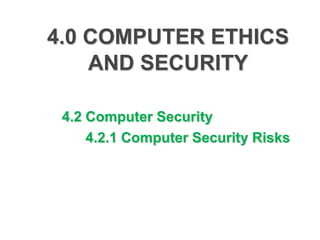
Computer Security Risks
- 1. 4.0 COMPUTER ETHICS AND SECURITY 4.2 Computer Security 4.2.1 Computer Security Risks
- 2. LEARNING OUTCOMES: At the end of this topic, students should be able to: Define computer security risks. Identify types of security risks. 2
- 3. DEFINITION • Computer Security Risks is any event or action that could cause a loss of or damage to computer hardware, software, data, information, or processing capability. 3
- 4. Types of Computer Security Risks
- 5. Types of Computer Security Risks Internet and network attack Unauthorized access and use Hardware theft Software theft Information theft System failure 5
- 6. 1. Internet and network attacks • Information transmitted over networks has a higher degree of security risk than information kept on an organization’s premises.
- 7. 1. Malware 5. Spoofing Internet and network attacks 2. Botnets 4. Denial of service attacks 3. Back Doors 7
- 8. 1a.Malware • Malware (malicious software) – which are program that act without a user’s knowledge and deliberately alter the computer operation. • Type of malware: i. Computer viruses ii. Worms iii. Trojan Horses iv. Rootkit v. Back door vi. Spyware
- 9. Malware Symptoms Malware • Operating system runs much slower than usual • Available memory is less than expected • Files become corrupted • Screen displays unusual message or image • Music or unusual sound plays randomly • Existing programs and files disappear 9
- 10. Malware Symptoms Malware • Programs or files do not work properly • Unknown programs or files mysteriously appear • System properties change • Operating system does not start up • Operating system shuts down unexpectedly 10
- 11. Malware 1. Worm Is a program that copies itself repeatedly, for example in memory or on a network, using up resources and possibly shutting down the computer or network. 11
- 12. Malware 2. Computer Virus is a potentially damaging computer program that affects, or infects, a computer negatively by altering the way the computer works without the user’s knowledge or permission. 12
- 13. Malware 2. Computer Virus it can spread throughout and may damage files and system software, including the operating system. 13
- 14. Internet and network attacks Malware 3. Trojan horse Is a program that hides within or looks like a legitimate program. It does not replicate itself to other computers. 14
- 15. Internet and network attacks Malware 3. Trojan horse it can spread throughout and may damage files and system software, including the operating system. 15
- 16. Internet and network attacks Malware 4. Rootkit •Is a program that hides in a computer and allows someone from a remote location to take full control of the computer. •The rootkit author can execute programs, change settings, monitor activity, and access files on the remote computer 16
- 17. Internet and network attacks Malware 5. Spyware & Adware • Spyware is a program placed on a computer without the users knowledge that secretly collects information about the user. • Adware is a program that displays an online advertisement in a banner or pop-up window on web pages, e-mail messages or other internet services 17
- 18. 1b.Botnets • a group of compromised computers connected to a network such as the Internet that are used as part of a network that attacks other networks, usually for nefarious purposes.
- 19. 1c.Back Door • A program or set of instructions in a program that allow users to bypass security controls when accessing a program, computer, or network
- 20. 1d.Denial of Service Attacks Denial of service attacks or DoS attack, is an assault whose purpose is to disrupt computer access to an Internet service such as the Web or e-mail.
- 21. 1e.Spoofing • A technique intruders use to make their network or Internet transmission appear legitimate to a victim computer or network.
- 22. 2.Unauthorized Access and Use Unauthorized access The use of a computer or network without permission. Unauthorized use The use of a computer or its data for unapproved or possibly illegal activities.
- 23. 3.Hardware Theft and Vandalism Hardware theft Is the act of stealing computer equipment. Hardware vandalism The act of defacing or destroying computer equipment.
- 24. 4.Software Theft Steals Intentionally software erases media programs Illegally Illegally registers copies a and/or program activates a program
- 25. 5.Information Theft Occurs when someone steals personal or confidential information. If stolen, the loss of information can cause as much damage as (if not more than) hardware or software theft.
- 26. System Failure A system failure is the prolonged malfunction of a computer A variety of factors can lead to system failure, including: • Aging hardware • Natural disasters • Electrical power problems • Noise, undervoltages, and overvoltages • Errors in computer programs